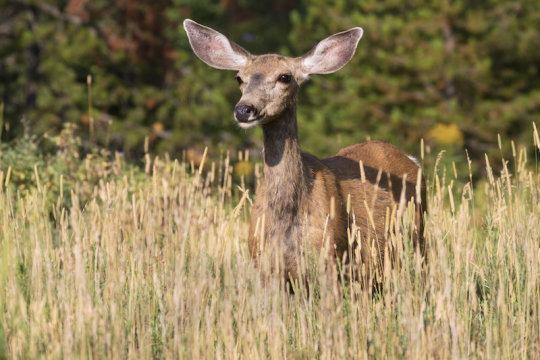[ad_1]
How do big-game animals know where to migrate across hundreds of miles of vast Wyoming landscapes year after year?
Among scientists, there are two camps of thought. First is that animals use local cues within their vicinity to determine where to migrate. Animals might move up to areas with greener forage — often termed green-wave surfing — or move down from mountains with deeper snow. The second idea is that animals develop memory of the landscape where they live and then use that information to guide their movements.
Recent research from the University of Wyoming has found that memory explains much of deer behavior during migration: Mule deer navigate in spring and fall mostly by using their knowledge of past migration routes and seasonal ranges.
The study found that the location of past years’ migratory route and summer range had 2-28 times more influence on a deer’s choice of a migration path than environmental factors such as tracking spring green-up, autumn snow depth or topography.
“These animals appear to have a cognitive map of their migration routes and seasonal ranges, which helps them navigate tens to hundreds of miles between seasonal ranges,” says the lead author of the paper, Jerod Merkle, assistant professor and Knobloch Professor in Migration Ecology and Conservation in the Department of Zoology and Physiology at UW.
The findings recently were published in Ecology Letters, a leading journal within the field of ecology. Co-authors of the paper included Hall Sawyer, with Western EcoSystems Technology Inc.; Kevin Monteith and Samantha Dwinnell, with UW’s Haub School of Environment and Natural Resources; Matthew Kauffman, with the U.S. Geological Survey Wyoming Cooperative Fish and Wildlife Research Unit at UW; and Gary Fralick, with the Wyoming Game and Fish Department.
Scientists had long presumed that migratory behavior was dictated by availability of food resources and other external factors. Where you find resources, you will find species that exploit them, the theory went.
The UW team found it is not that simple. Without the intrinsic factor of landscape memory to guide deer between seasonal ranges, the long-distance corridors of western Wyoming’s Green River Basin, for example — exceeding 300 miles round-trip in some cases — would not exist in their present form.
“It appears that green-wave surfing helps them determine when to move within a kind of ‘map’ in their brain,” Merkle says. “The timing of spring green-up determines when an animal should migrate, but spatial memory determines where to migrate.”
The finding has important conservation implications. Because landscape memory so strongly underlies mule deer migratory behavior, the loss of a migratory population also will destroy the herd’s collective mental map of how to move within a landscape, making it very difficult to restore lost migration routes. Patches of potential habitat likely will go unused.
“This is yet another study that makes clear that animals must learn and remember how to make these incredible journeys,” say Kauffman, who leads the Wyoming Cooperative Fish and Wildlife Research Unit, where the research was conducted. “This is critical for conservation, because it tells us that, to conserve a migration corridor, we need to conserve the specific animals who have the knowledge necessary to make the journey.”
The study bolsters the findings of a 2018 paper in the journal Science by a UW-led team that found translocated bighorn sheep and moose with no knowledge of the landscape can take anywhere from several decades to a century to learn how to migrate to vacant habitats.
Similarly, strategies such as off-site restoration or mitigation may be unsuccessful if restored habitats are not “discovered” and integrated into the memory of individuals.
The study further makes a case that biologists will not be able to successfully predict migration corridors — or optimally manage populations — based on environmental information or range quality alone. Managers will find it difficult to evaluate potential conservation actions without directly gathering movement data, crucial information that reveals the migration knowledge that animals carry around in their heads.
Moreover, the research shows that migrants can obtain greater forage benefits during spring migration using memory of a vast landscape, compared to migrants that rely simply on foraging cues in their local area.
This suggests that the migratory routes we see today are optimized across generations for green-wave surfing in large landscapes. These learned migration corridors are not readily discoverable by animals if they cannot access the memories established by past generations.
[ad_2]















